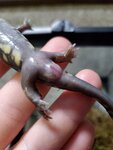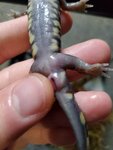Walt3737
New member
So I finally got myself a tiger salamander after wanting and looking for a long time. I bught a beautiful juvenile texas barred from a guy in PA on faunaclassifieds.com. I recieved him about 2 weeks ago. He was healthy and active and ate like a champ for almost the whole 2 weeks. I fed him dusted crickets and red wrigglers.
So on Saturday I noticed he was acting strangely. He would not take food. Although he ate 2 crickets on friday so I wasn't concerned. I went out Saturday and got home at night and noticed more strange behavior as well as what looked like bloating. I sprayed him down real good for the second time of the day. But I was still worried so I put him in a small tubaware with a little declorinated water. The tubaware was about the length of his body. As soon as I put him in he freaked out, started contorting his body back and forth with his mouth open. I returned him to his tank and then got a small plastic tank which was bigger because I wanted him to soak in some water. I put paper towels this time with water. He seemed fine and was walking a little so I left him for an hour and checked again. This time there was 2 spots of what had to be blood. 2 red spots and one of them had some kind of physical matter in it. Didnt look like poop but I don't know.
So i changed the paper towel and water and added some moss. I checked his belly for any cuts or sores and there was nothing. So I left him for the night. He seemed ok his eyes were open and he was somewhat responsive. Needless to say sunday morning he was dead. He went from eating on friday to dead on Sunday morning. I am still beside myself about this.
One very important detail is his/her private part. On Sunday when I looked his body over the genitalia was very red. I opened it up and inside looked infected, all red. Im guessing he pooped or peed blood the night before.
His setup was all coconut fiber with moss on top. I misted him daily multiple times with declorinated water. He also had a log hide in his tank as well as isopods and springtails. The temp was kept between the low 60s to 72 at the most.
I just don't understand. I successfully kept a spotted salamander for 8 years. As well as many different frogs and reptiles. I've had pets my whole life. I need to know what went wrong. Please help me learn from this. I provided pics of his underside where it looks infected. Thank you for reading.
So on Saturday I noticed he was acting strangely. He would not take food. Although he ate 2 crickets on friday so I wasn't concerned. I went out Saturday and got home at night and noticed more strange behavior as well as what looked like bloating. I sprayed him down real good for the second time of the day. But I was still worried so I put him in a small tubaware with a little declorinated water. The tubaware was about the length of his body. As soon as I put him in he freaked out, started contorting his body back and forth with his mouth open. I returned him to his tank and then got a small plastic tank which was bigger because I wanted him to soak in some water. I put paper towels this time with water. He seemed fine and was walking a little so I left him for an hour and checked again. This time there was 2 spots of what had to be blood. 2 red spots and one of them had some kind of physical matter in it. Didnt look like poop but I don't know.
So i changed the paper towel and water and added some moss. I checked his belly for any cuts or sores and there was nothing. So I left him for the night. He seemed ok his eyes were open and he was somewhat responsive. Needless to say sunday morning he was dead. He went from eating on friday to dead on Sunday morning. I am still beside myself about this.
One very important detail is his/her private part. On Sunday when I looked his body over the genitalia was very red. I opened it up and inside looked infected, all red. Im guessing he pooped or peed blood the night before.
His setup was all coconut fiber with moss on top. I misted him daily multiple times with declorinated water. He also had a log hide in his tank as well as isopods and springtails. The temp was kept between the low 60s to 72 at the most.
I just don't understand. I successfully kept a spotted salamander for 8 years. As well as many different frogs and reptiles. I've had pets my whole life. I need to know what went wrong. Please help me learn from this. I provided pics of his underside where it looks infected. Thank you for reading.



